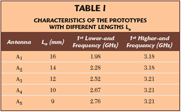
In recent years, wireless communications have progressed very rapidly. The IEEE 802.16 Working Group has created a new standard, commonly known as WiMAX (Worldwide Interoperability for Microwave Access), for a low cost, broadband, wireless access at high speed, which is easy to deploy.1 WiMAX technology can reach a theoretical 30-mile radius coverage and achieve data rates up to 75 Mbps, a throughput higher than the 1.5 Mbps performance of typical broadband services.2 At present, the development of WiMAX technology is the focus of the receiving industry. How to design the antennas for WiMAX applications has become important.
Microstrip-line slot antennas are light and easy to manufacture, are broadband, and have low profile and low cost. Several designs of broadband slot antennas have been proposed.3–5 WiMAX has been allocated three frequency bands, which will be called the low band (2.495 to 2.695 GHz), the median band (3.25 to 3.85 GHz) and the high band (5.25 to 5.85 GHz), respectively. A broadband antenna must add filters to separate the bands, leading to a higher cost. Therefore, a broadband antenna is not very suitable for WiMAX. A wideband stubby monopole was reported6 that is broadband but with a more complex structure. To design a triple-band antenna that fit the exact bands of WiMAX is not an easy task. In this article, a new design for a microstrip-line-fed printed polygonal slot antenna, with two rectangular narrow strips to obtain the dual band-rejected frequencies at 3 and 4.5 GHz, is proposed. The proposed antenna can easily be excited by a 50 Ω microstrip-line, printed on an FR-4 dielectric substrate. With this antenna design, a good impedance match and good radiation characteristics can be obtained. Details of the design and the experimental results of the proposed antenna are discussed.

Antenna Design
Figure 1 shows the geometry of the broadband design of the polygonal slot antenna on a dielectric substrate. In this study, the dielectric material is FR-4, with a thickness h and a relative permittivity εr. For design convenience, the proposed antenna is fed by a 50 Ω microstrip-line, printed on the dielectric substrate. The microstrip-line was placed symmetrically with respect to the centerline (y axis) of the polygonal slot. Then, by fine-tuning the polygonal slot and adjusting the length of the 50 Ω microstrip-line, a new resonant mode can be excited in the proximity of the fundamental resonant mode, and a good impedance matching over a broadband can be obtained. Then, two rejected bands are created, located at the proper frequencies to form the triple frequency bands used in WiMAX applications. Figure 2 shows the geometry of the triple-band polygonal slot antenna on a dielectric substrate. Two narrow strips are inserted along the centerline of the polygonal slot. The width of the strips, ws, is equal the width wf of the microstrip-line. In order to reject two different frequency bands, the length of strip A is different from strip B. Strip A is connected to the ground plane of the polygonal slot antenna and its length is adjusted to reject the frequency band from 2.69 to 3.3 GHz. Strip B, which is coupled to the 50 Ω microstrip-line, is approximately a quarter-wavelength at the center frequency of the second rejected band (4.525 GHz). With two strips inserted, the polygonal slot antenna will have two rejected bands, leading to a triple-band WiMAX antenna.

Experimental Results and Discussion
Polygonal Slot Antenna
Figure 3 shows the measured and simulated return loss of the polygonal slot antenna. The simulation was performed using the high frequency structure simulation (HFSS) software package from Ansoft, and the prototype characteristics of the proposed antenna were measured with a HP-8072E network analyzer. The impedance bandwidth was greater than 100 percent (1.85 to 5.83 GHz) for a VSWR = 2.0. The broadband property of the polygonal slot antenna is obvious.
Inserted Different Values of the Strip A
Figure 4 shows the measured return loss of the antenna, with a strip A of different lengths La inserted. As the length La decreases, the center frequency of the rejected band shifts to a higher frequency. When La= 9 mm, the lower end frequency of the first rejected band is above 2.695 GHz. It is observed that when La decreases, the higher end frequency of the first rejected band is slightly affected. The related results are listed in Table 1 with the parameters wf = ws = 3.0 mm, h = 1.6 mm, εr = 4.4.

Inserted Different Values of the Strip B
Figure 5 shows the measured return loss of the antenna with a strip B of different lengths Lb inserted. As Lb decreases, the center frequency of the second rejected band shifts to a higher frequency. When Lb = 17 mm, the frequency of the second rejected band ranges from 3.99 to 5.1 GHz. It is suitable for the present application, between the low and median bands. The length Lb is approximately a quarter-wavelength at the center frequency of the second rejected band (4.525 GHz). The higher end frequency of the second rejected band is greater than 5.25 GHz when Lb is less than 17 mm. Thus, setting Lb= 17 mm is a good choice for the present design. The related results are listed in Table 2, with the same parameters as in Table 1.
Combined Strip A and Strip B Proposed Antenna Design
From what has been investigated, the relatively suitable strip lengths are La = 9 mm and Lb = 17 mm. After inserting the strips A and B simultaneously in the polygonal slot, the triple-band antenna for WiMAX applications can be obtained. Figure 6 shows the measured and simulated return loss of the proposed antenna. The three bandwidths (1.95 to 2.73 GHz, 3.27 to 3.99 GHz and 5.1 to < 6 GHz) are suitable for the WiMAX frequency bands. Figure 7 shows the impedance of both the proposed and broadband antennas. The real part of the impedance of the rejected band antenna is significantly increasing at the center frequency of the first and second rejected bands (2.995 and 4.525 GHz), and the maximum peak impedance of the second rejected band is 248 Ω. The variation of the imaginary part of the impedance of the proposed antenna, around the center frequency of the rejected bands, is larger than that of the broadband antenna. Figure 8 and 9 show the measured radiation patterns in the x-z and y-z planes, at 2.5 and 5.75 GHz, for the proposed design. The radiation characteristics were also investigated. Figure 10 shows the gain of the proposed antenna. The maximum peak antenna gains for the three operating bands are 5.7, 3.9 and 5.8 dBi, respectively, and the gain variations within the three bands are less than 2.9 dBi. The good gain characteristics of the antenna are very suitable for WiMAX applications.

Conclusion
A novel polygonal slot antenna for WiMAX applications has been implemented. Inserting two narrow strips along the centerline of the polygonal slot antenna leads to two rejected bands, from which the triple-bands for WiMAX applications can be obtained. The triple-bands of the proposed design satisfy the WiMAX standard. The proposed antenna can be easily excited by a 50 Ω microstrip-line printed on the FR-4 dielectric substrate, and good impedance matching can be obtained for the three operating frequency bands of WiMAX. The good gain of the proposed antenna is very suitable for WiMAX applications.

Acknowledgment
The financial support of this study by the National Science Council, Taiwan, Republic of China, under contact number NSC94-2213-E-218-006, is greatly acknowledged.
References
1. H.Y. Wei, S. Ganquly, R. Izmailov and Z.J. Haas, “Interference-aware IEEE 802.16 WiMAX Mesh Networks,” 2005 IEEE Vehicular Technology Society International Symposium Digest, Vol. 5, pp. 3102–3106.
2. Deploying License-exempt WiMAX Solutions, http://www.intel.com/netcomms/technologies/wimax/.
3. Y.F. Liu, K.L. Lau, Q. Xue and C.H. Chan, “Experimental Studies of Printed Wide-slot Antenna for Wideband Applications,” IEEE Antennas and Wireless Propagation Letters, Vol. 3, 2004, pp. 273–275.

4. H.L. Lee, H.J. Lee, J.G. Yook and H.K. Park, “Broadband Planar Antenna Having Round Corner Rectangular Wide Slot,” 2002 IEEE Antennas and Propagation Society International Symposium Digest, Vol. 2, pp. 460–463.
5. Y.W. Jang, “Broadband Cross-shaped Microstrip-fed Slot Antenna,” Electronics Letters, Vol. 36, 2000, pp. 2056–2057.
6. T. Liu and K.L. Wong, “A Wideband Stubby Monopole Antenna and a GPS for WiMAX Mobile Phones with E911 Function,” Microwave and Optical Technology Letters, Vol. 46, 2005, pp. 485–487.

Wen-Shan Chen received his BS degree in electronic engineering technology from the National Taiwan Institute of Technology (now the National Taiwan University of Technology) and his PhD degree from National Sun Yat-Sen University, Kaohsiung, Taiwan, ROC, in 2001. From 2001 to 2002, he was an assistant professor at the Chien-Kuo Institute of Technology, Changhua, Taiwan, ROC. He is currently an assistant professor of electronic engineering at the Southern Taiwan University of Technology, Tainan, Taiwan, ROC. His research interests include antenna design, RF and microwave circuits.
Bao-Hung Kao received his BS degree from the Southern Taiwan University of Technology, Taiwan, ROC, in 2004. He is currently a student in the university’s department of electronic engineering, where he is working toward a master’s degree. His research interests include printed antenna for wireless communications and printed slot antenna for WiMAX applications.





Wen-Shan Chen

Bao-Hung Kao
